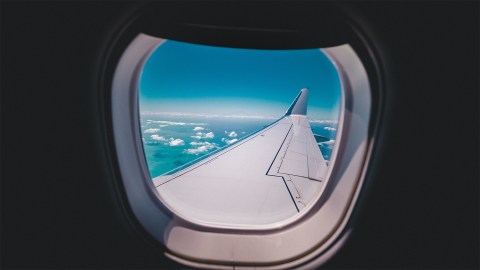Here’s how AI, VR, and AR will change the way you vacation

Project Time Off has reported that American vacations are at an all-time high, with U.S. workers taking an average of 17.2 vacation days in 2017, which is at an all-time high since 2010 (17.5 vacation days.) For reference, in 2014 U.S. workers took only 16 vacation days, a record low. There is still plenty of room for improvement, however – 52% of U.S. workers have left unused vacation time go to waste, and 24% of U.S. workers have not taken a vacation in over a year.
Not to fear, however – Bill Gates believes that Artificial Intelligence (AI) can make our lives better!
“Machine learning will make humans more productive and therefore able to accomplish the same amount of work in less time,” says Gates. That’s a good thing, he says, because “the purpose of humanity is not just to sit behind a counter and sell things. More free time is not a terrible thing.”
In a nutshell, Gates and his friend Warren Buffet (the CEO of Berkshire Hathaway and investment guru) believe that automation will free up time, allowing some workers to be significantly more productive and free up resources for “all kinds of possibilities for everything else.”
We understand that automation and technology will make it easier for U.S. workers to actually get to their vacations. But how is technology changing the vacations themselves?
AI makes booking and traveling easier
Artificial Intelligence is in a lot of the digital technologies you are already using to interact with the world. From your preferred Maps app to voice assistants like Siri and Cortana to many of the online travel apps, artificial intelligence is creating a more straightforward way to travel.
Booking.com Global Director of Customer Service James Waters says that Booking.com customers prefer – by about 80% – to get the information they need for their travel themselves. AI helps them accomplish their tasks, largely behind the scenes.
Many AI programs now have names, in a push for the technology to be received better. (Some of the names are kind of fun – Mezi is a shopping assistant, Carla is a personal travel assistant that helps with policy-compliant trips, and Claire is a B2B travel management bot.) Many of these AI-based programs are meant to be a travel companion – if you’re traveling alone, don’t fret. Your trusty travel app has your back!
Lola, for example, is a travel app in which AI operates as your personal travel assistant, instant messaging you and connecting you with a real-life travel agent. The AI pairs your preferences to travel accommodations that you would prefer, airlines that meet your needs and keeps all of your booking information in one place. All of this data is available in an online platform (app) that can easily be super hands-on, or managed with the assistance of a real-life travel agent.
AI has enabled the travel industry to compete based on relevance, helping to personalize services, manage pre-, in-, and post-trip needs, predict future travel choices, and complete bookings. Pretty fancy stuff.
Artificial Intelligence also has helped the travel industry by:
- Creating conversational and digital interactions for booking travel
- Enabling agencies to increase security, while lessening the impact on travelers (think of facial recognition for embarking on a cruise)
- Improving machine learning to increase in-airport sales, building recommendations for commonly forgotten items
- Conversing with users to persuade them to use their vacation days on specifically tailored travel
AI has even helped with social media, creating a funnel in which complaints can be handled in a more prompt manner, and praise can be shared with millions. Mindtree’s PaxPulse, for example, monitors real-time social posts, and reaches out to customers if they’re expressing negative emotions (like the frustration for a delayed flight), delivering resolutions that can stem negative feelings and foster positive ones.
- Make travel recommendations (think Google date tips)
- Provide dynamic pricing
- Give real-time travel assistance
- Fly your plane (Boeing is making a pilotless airplane!)
- Improve the concierge-quality in hotels and airports
VR helps consumers “try before you buy”
Virtual Reality (VR) is changing the travel game – before a consumer even begins to plan their vacation.
Gone are the days in which a photo editor would have to manually paste together multiple still-frame snaps to create a collage. Now, there are 360-degree cameras. The multiple lenses capture absolutely everything, in every direction. The software (in real-time) stitches the images together instantly, producing photos and videos that a visitor can immerse themselves in.
VR isn’t just for someone who buys a headset anymore, either – on any of the major platforms (Facebook, YouTube, Twitter), you can experience VR with 360 photos. No matter what device you are currently using, VR is there – just drag left or right or in whichever direction you choose to explore your new, digital surroundings. For the consumer, they can gobble it all up, live, in 4K resolution.
VR has changed the tourism industry in such a way that destinations now have to compete with resorts and other destinations that are providing their potential customers with in-depth, immersive looks into what it’s like to stay there.
Take Las Vegas, for example: The Convention and Visitors Authority showcases a 360 video of a helicopter tour over the city. Quark Expeditions gave their Facebook followers an immersive video of a penguin colony.
VR is changing the travel industry by letting you grab your cell phone and see a 360 video or panorama of what your vacation would look like. Or, you could grab your VR headset and experience where you airline seat would be; what your rental car could look and feel like; what your accommodations offer; what you can see and experience while you travel.
There are even companies who (are in the process of) making all-in-one experiences through which you can put on your headset, pick out what you like, add it to your cart, and purchase it – all without having to take off your headset, or leave your immersive experience.
AR will be used for more than just catching Pokémon
Augmented Reality, or the technology that lays a virtual world on top of your current, live one, is growing in popularity. AR has grown from the warm reception of its predecessors, AI and VR. While top tech companies have a few ideas for the future of AR, their three main projections include:
- That AR will be consumer-focused
- The physical and digital world will be indistinguishable
- AR will expand into your other senses (like touch and smell)
Currently, popular tourist destinations are thinking of creative new ways in which they can use AR. The Museum of Natural History has their Skin and Bones app, in which you can hold up your phone over a set of skeletal remains and see what the animal might have looked like while it was still alive.
Zoos can use AR overlays to show how an animal would live in the wild, or fill in for those who are needing a break. Locations that aren’t accessible can now become immersive experiences, allowing those who would previously be barred from traveling up five flights of stairs to experience the same wonder as their more able-bodied companions.
Together, AR, VR, and AI are changing the travel industry, making booking easier, shopping more seamless, and experiences more enriching.





